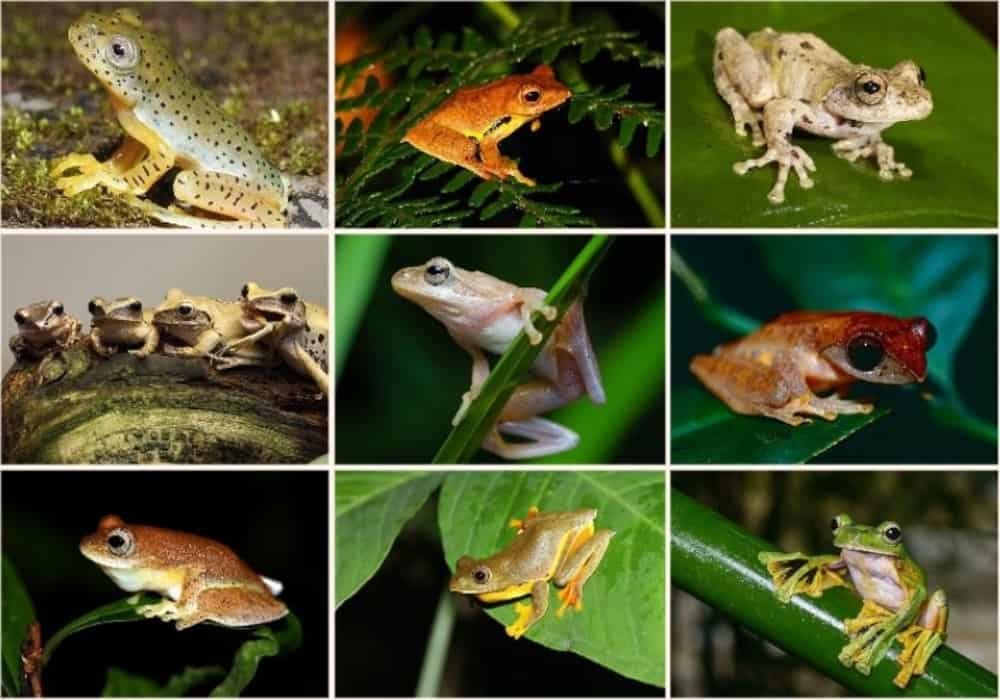Flying Frogs
The Rhacophoridae are a family of frogs (flying frogs) that occur in tropical sub-Saharan Africa, South India and Sri Lanka, Japan, northeastern India to eastern China, south through the Philippines and Greater Sundas, and Sulawesi. They are commonly known as shrub frogs, or more ambiguously as “moss frogs” or “bush frogs”. Some Rhacophoridae are called “tree frogs”. Among the most spectacular members of this family are numerous “flying frog”.
It is estimated that there are more than 3000 different species of flying frogs, included in two distinct families: Hylidae, endemic to the American continent , and particularly to the rainforests of South America, and Rhacophoridae, endemic to Asia, particularly in the monsoon jungles of South East Asia. Sometimes with the term of flying frogsit mainly refers to the members of the latter family, the first to be observed and described and which has the greatest number of members. However, both families also include many non “flying” arboreal species.

Some species flying frog
- Rhacophorus dulitensis (Jade tree frog)
- Rhacophorus nigropalmatus (Wallace’s flying frog)
- Rhacophorus pardalis (Harlequin tree frog)
- Rhacophorus reinwardtii
- Rhacophorus suffry or Zhangixalus suffry from eastern Himalayas
- Rhacophorus vampyrus (Vampire Flying Frog) from Vietnam
- Rhacophorus helenae (Helen’s tree frog)
- Rhacophorus malabaricus (Malabar gliding frog)
Helen tree frog
Helen tree frog (scientific name Rhacophorus helenae) is a species of flying frog discovered in Vietnam and published in 2013, named after Helen M. Rowley, the mother of the person who discovered and described this species. This species lives in Binh Thuan and Dong Nai , from Nui Ong Nature Reserve , Binh Thuan province to watershed protection forests in Thac Mai, Tan Phu, Dong Nai.
Racophorus helenae is a rather peculiar frog. It can soar in the forests of Southeast Asia thanks to the wide webs of its legs. The Flying Frogs are tree frogs from Southeast Asia that have very developed webs between the fingers, in addition to those between the toes, the latter almost generalized. This allows them to soar as they jump from tree to tree to escape their predators. They do not really produce a flight, however are classified under this term only species capable of falling at an angle less than 45° from the horizontal. Other frogs drop but it is more of a “parachuted” flight with an angle greater than 45°.
Wallace flying frog
The Wallace flying frog (Rhacophorus nigropalmatus) is a species from the genus of the actual rowing frogs. With the help of the membranes between his toes he can sail up to 20 meters (around 66 feet). It is named after the British naturalist Alfred Russel Wallace, who explored the Malay Archipelago in the mid-19th century and sent the first specimens of this flying frog to Europe.
Distribution and habitat (This species is found):
- in the Malay Peninsula in Peninsular Malaysia and in southern Thailand;
- in Indonesia on the island of Sumatra;
- on the island of Borneo.
They live in humid evergreen forest and underbrush.

Reproduction
Most of flying frogs in early spring, males call females with their songs. They enclose these under the armpits (axillary coupling). They are then on a branch which overhangs a water point. Females secrete a sort of scum that males beat with their hind legs to form a sort of nest. The females lay their eggs in this nest which has become firm. These hatch after 2-3 days. The next time it rains, the tadpoles will fall into the water because the foam nest will be damaged. They may fall forward due to their repeated movements. Tadpoles (larval stage in the life cycle of an amphibian) take 3 weeks to metamorphose into frogs. New frogs reach sexual maturity after two years.
Sources: PinterPandai, BioOne, Sci-News, National Geographic, Jstor
Photo credit (main photo): Se Coucher Moins Bête



